Historic Homes of the Hamptons
Amid the modern-day waterfront mansions of the Hamptons are a number of historically notable homes. These include a 17th-century farmstead, the last project of famed architect Stanford White, and the home and studio of painters Jackson Pollock and Lee Krasner.
James L. Breese House
155 Hill Street, Southampton
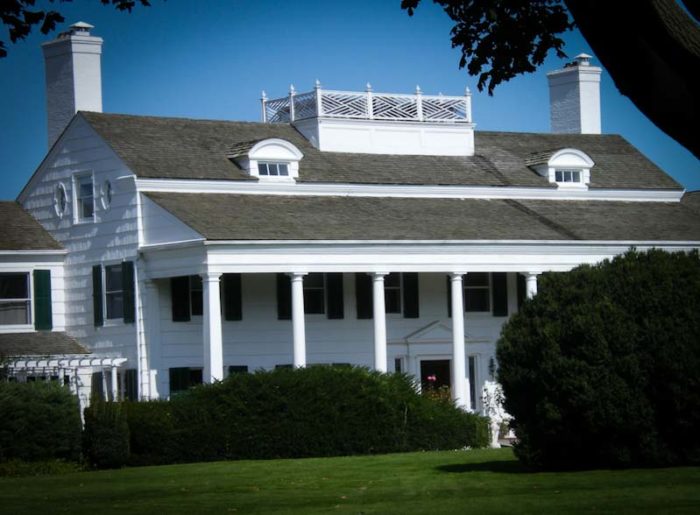
The James L. Breese House. Image: Americasroof/Wikimedia
When Wall Street stockbroker and photographer James Breese purchased this 30-acre property in 1897, it already included a modest cottage that had been built in 1858. Given that Breese ran in the same circles as the Vanderbilts, “modest” simply would not do. Fortunately one of his closest friends was Stanford White, of the renowned McKim, Mead & White architectural firm, whom he hired to expand the summer home to suitable Gilded Age proportions. Among White’s most notable additions were a two-story portico and the opulent 70-foot-long music room, which boasted carved mahogany walls and a coffered ceiling with hand-painted details. This room is believed to be White’s final project; he was said to still be working on other areas of the home when he was murdered in 1906 by Henry Kendall Thaw, who was jealous of White’s earlier relationship with Thaw’s wife, former chorus girl Evelyn Nesbit. Breese owned the home, known as the Orchard, until 1926. It later was owned by fellow stockbroker Charles E. Merrill, of Merrill Lynch & Company. Now known as Whitefield, today it encompasses five condo units, and 24 townhouses are sited on the rest of the property.
William Corwith House
2368 Main Street, Bridgehampton
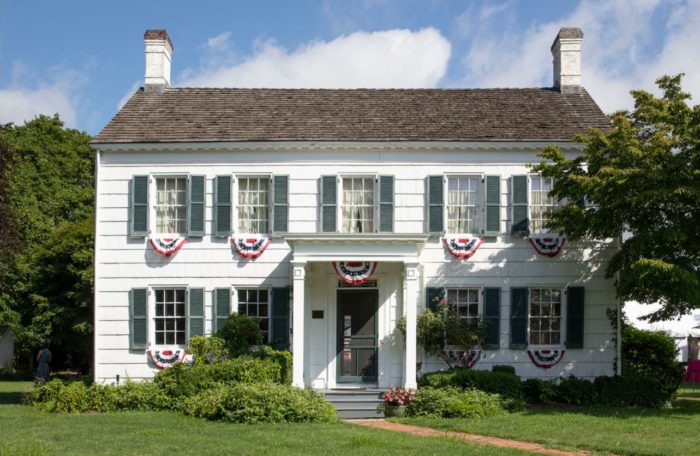
The William Corwith House. Image: the Bridgehampton Historical Society
Built circa 1825, this Federal-style, shingle-clad home stayed in the Corwith family until 1960, when it was donated to the Hampton Library. The Bridgehampton Historical Society bought it in 1972 to use as its headquarters. Open to the public, the house includes the society’s collection of historic textiles and hosts exhibits. In 1977 the Bridgehampton Lock-up, a short-term jail for local criminals built in 1907, was moved to the house’s grounds.
The Foster-Meeker House
101 Mill Road, Westhampton Beach
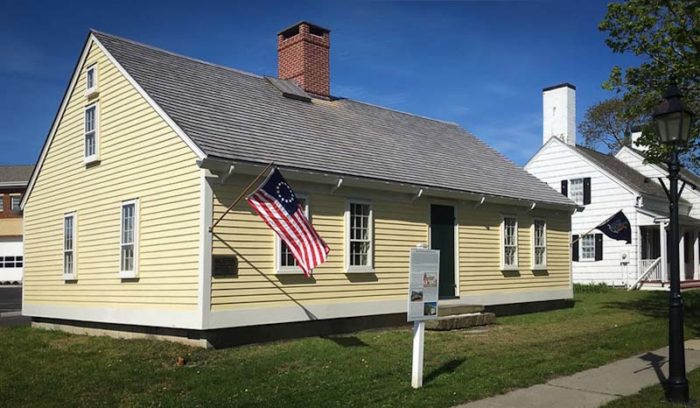
The Foster-Meeker House. Image: the Westhampton Beach Historical Society
Believed to be the oldest surviving building in Westhampton Beach, the Foster-Meeker House was built circa 1735 and originally located on Main Street. Originally a single-story home, it later gained a second story that expanded it to 1,100 square feet. When the Cape Cod-style home was threatened in 2008 with being razed to make room for a mansion that wanted to take advantage of the waterfront view, the Westhampton Beach Historical Society relocated it to its current location and began restoring the timber-frame structure.
Grey Gardens
Three West End Road (at Lily Pond Lane), East Hampton
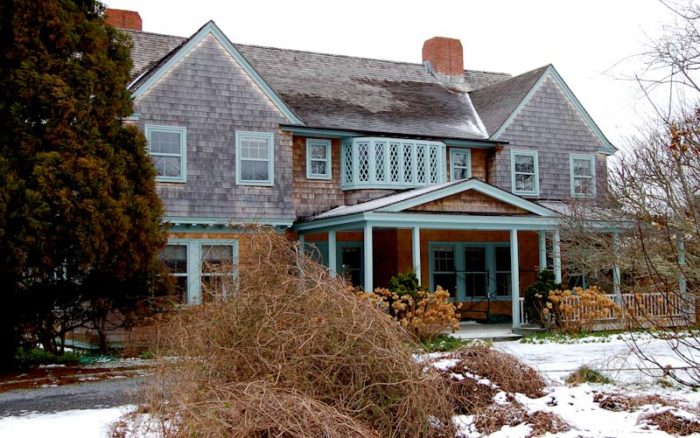
Grey Gardens while under the ownership of Ben Bradlee and Sally Quinn. Image: Taber Andrew Bain/Flickr
Those expecting this early 20th-century mansion to be in the dilapidated state as seen in the 1975 documentary of the same name will be either delightfully surprised or disappointed. When journalism power couple Ben Bradlee and Sally Quinn bought Grey Gardens in 1979 for $220,000, they restored the 28-room home, a task that included ridding it of the output of 52 feral cats. Designed in 1897, built several years later, and enclosed by concrete walls imported from Spain in 1913, the home was bought in 1924 by Phelan Beale for his wife Edith Bouvier Beale, an aunt of Jacqueline Kennedy Onassis and Lee Radziwill. After divorcing Edith in 1946, Phelan gave her and their daughter, also named Edith, the home. “Big” Edie and “Little” Edie struggled to maintain the property, but even after the Suffolk County Health Commission ordered them to leave the by-now unsafe premises in 1972, they continued to live there along with a menagerie of cats and raccoons, without running water. Onassis and Radziwill subsequently paid to have the home restored to code. In 2017, three years after Bradlee’s death, Quinn sold Grey Gardens for $15.5 million.
Thomas and Mary Nimmo Moran Studio
229 Main Street, East Hampton
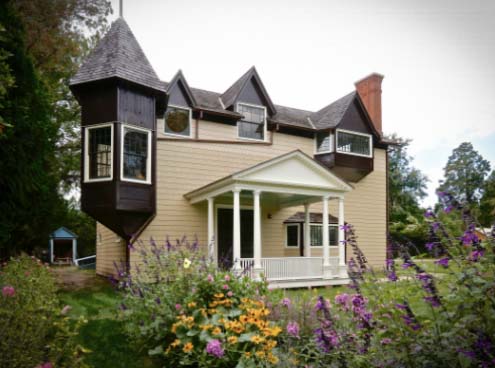
Thomas and Mary Nimmo Moran Studio. Image: East Hampton Historical Society
The abstract expressionists of the mid-20th century are the artists most associated with the Hamptons, but they were not the only ones to view the area as an idyllic place to establish studios. Thomas Moran, best known for his landscapes of the American West, and his wife, Mary Nimmo Moran, the first woman elected to London’s Royal Society of Painter-Etchers, were among the first to set up a studio here. They built a Queen Anne-style cottage in East Hampton in 1884 and spent about half of each year here until their deaths—Mary’s in 1899 and Thomas’s in 1926. Currently owned by the East Hampton Historical Society, the home was restored and opened to the public in 2018. On display are numerous works by both Morans of the local landscape and their gardens as well as a circa 1825 Greek Revival mantelpiece and a Federal-period mantelpiece that Thomas had salvaged for the home.
Mulford Farmstead
10 James Lane, East Hampton
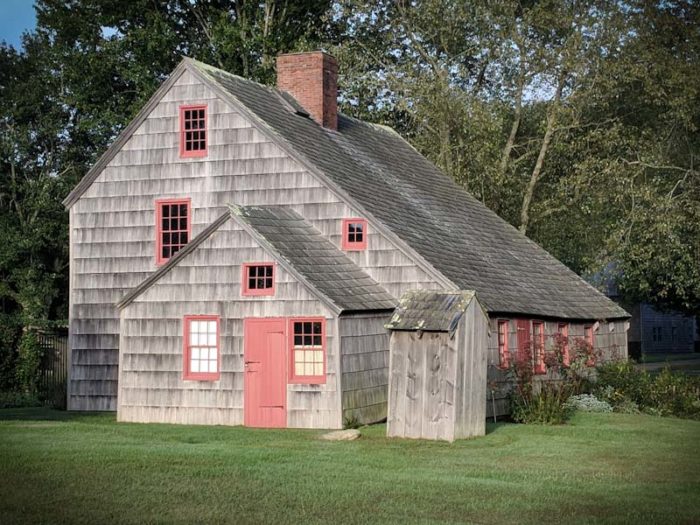
The Mulford Farmstead. Image: CaptJayRuffins/Wikimedia
This wood-frame farmhouse was built in 1680, for an official of the first New York Royal Province government. The second owner, Samuel Mulford, added a barn to the property in 1721. Few changes were made to the barn or the farmhouse after the mid-18th century, and the East Hampton Historical Society maintains the buildings and the garden as a museum demonstrating life on a pre-Revolution farm. The man for whom the property is named, incidentally, acquired an unusual nickname of his own: Fish Hook. The local assemblyman and one-time whaling-boat captain traveled to London in 1705 to protest a tax on whale oil; to circumvent pickpockets, he lined his pockets with, yes, fishhooks.
Pollock-Krasner House
830 Springs Fireplace Road, East Hampton
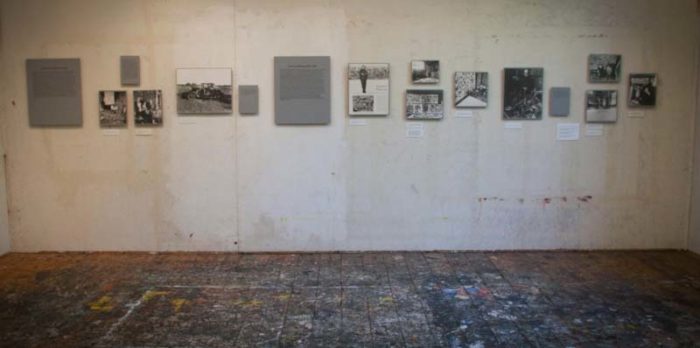
The floor of the Pollock-Krasner barn shows evidence of Jackson Pollock’s poured paintings. Image: Pollock-Krasner House
Husband-and-wife artists Jackson Pollock and Lee Krasner bought this 1879 house and barn, and the 1.5-acre lot on which they stood, in November 1945. Pollock turned the barn, previously used to store fishing gear, into his studio, painting “Autumn Rhythm,” “Convergence,” and more of his best-known “poured” paintings here. Krasner used the cottage bedroom as her studio until Pollock’s death in 1956, at which point she made the barn her studio. She continued to split her time between this house and New York City until her death in 1984. The studio and the house, now open to the public courtesy of the Stony Brook Foundation, still contain many of the artists’ possessions, from jazz records to paint supplies, along with some of their works.










